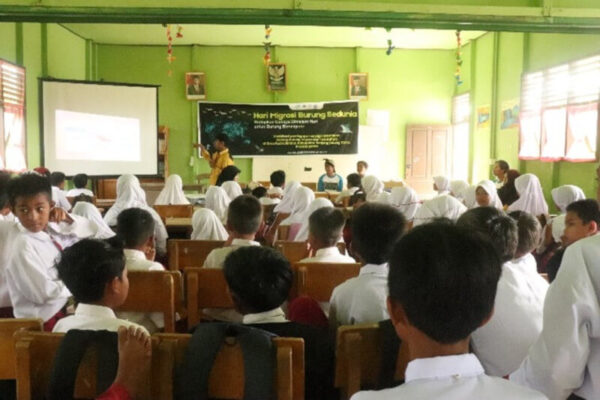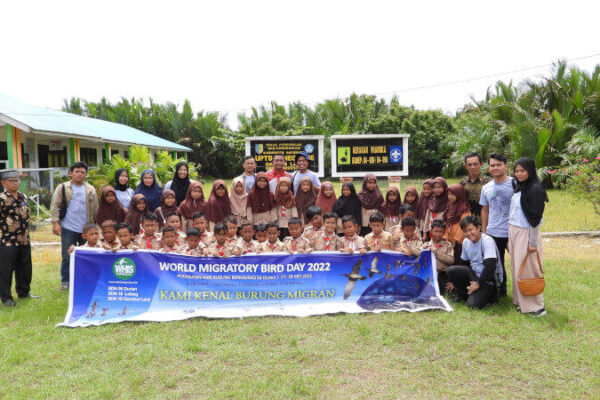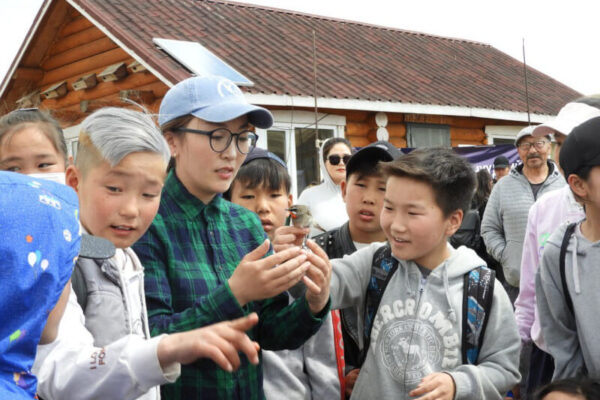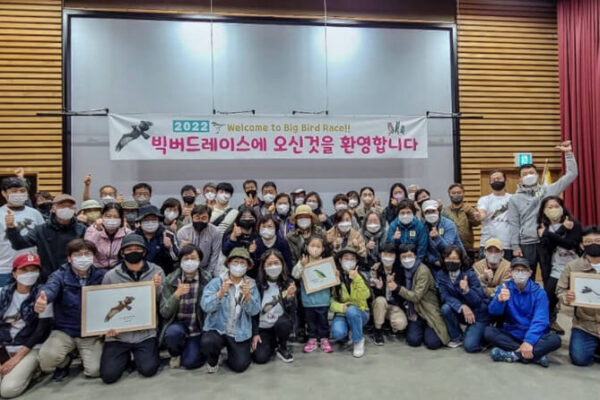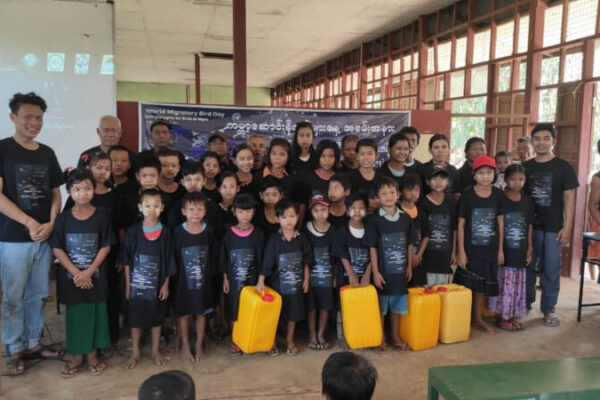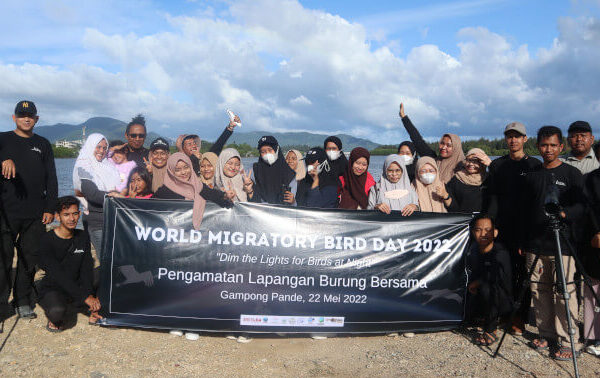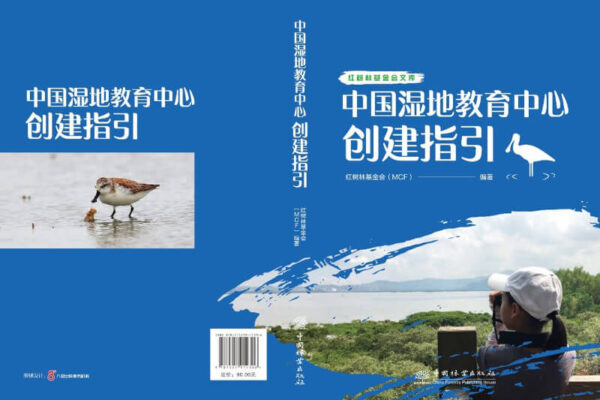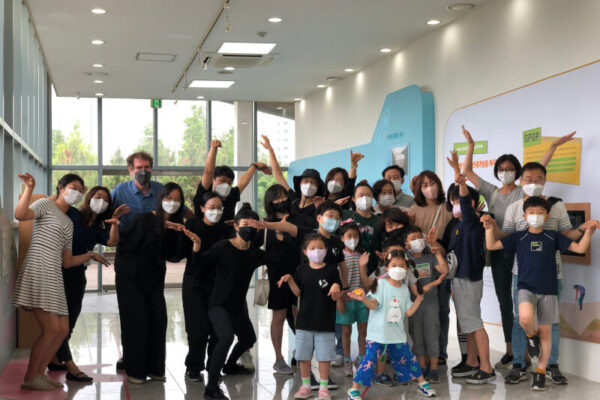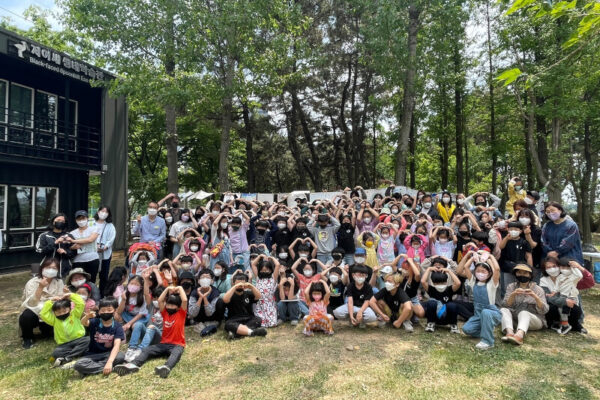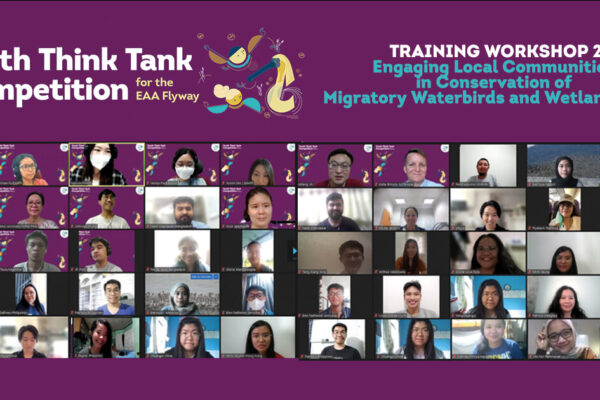-
Celebrating 2022 World Migratory Bird Day in Kuala Simbur Village, Jambi Province, Indonesia
Wildlife Observer Community (WOC) based in Indonesia was founded in 2017. Since then, WOC has been working on data collection, observation, research and conservation. In order to motivate and raise awareness amongst people and local community, WOC has been organizing awareness campaigns in Sumatra. Celebrating World Migratory Bird Day (WMBD) was one of the campaigns. Promotion of WMBD to local students ©️ WOC Under WOC regular conservation activity programme this year, the organization successfully organized two WMBD events in Kuala Simbur Village, Muara Sabak Timur, Tanjung Jabung Timur Regency, Jambi Province, Indonesia between 16 and 18 May 2022: field visit and birdwatching, and public awareness. Bird watching activity ©️ WOC A Field visit and Birdwatching was carried out in the Kuala Simbur Village, Muara Sabak Timur, Tanjung Jabung Timur Regency, Jambi Province, Indonesia as a place to observe migratory waterbirds for the first time. During the activity, the team did not find any large flocks of migratory waterbirds but found permanent migratory birds and some resident waterbirds. This can still be used as education for participants who took part in this activity by seeing the real conditions of migratory bird habitat in Kuala Simbur Village, Muara Sabak Timur, Tanjung Jabung Timur Regency, Jambi Province, Indonesia. The participants were very enthusiastic in participating in this activity. ©️ WOC WOC also organized an awareness-raising campaign among the local people and students close to the habitat of migratory birds. On 17 – 18 May, the project team conducted an awareness-raising campaign in SD Negeri 22/X Kuala Simbur, Madrasah Aliyah Bustanul Ulum, for local people. The goal of this activity was to provide knowledge on migratory birds and their migration to local people and children near the site. Village kids doing bird watching ©️ WOC The project team also met the Head of Kuala Simbur Village and he was very enthusiastic about this event because they provide knowledge to the surrounding community about migratory birds where the presence of migratory birds must be maintained by maintaining their habitat and dimming the lights.
Continue reading -
2022 World Migratory Bird Day Celebration in West, South and Eastern Mongolia
The celebration of World Migratory Bird Day (WMBD) 2022 in Mongolia by Wildlife Science and Conservation Center (WSCC) in West, South and Eastern Mongolia was a success. WSCC, Mongolia has been celebrated WMBD since 2010s by small grants or organization’s own funds every year with various public awareness activities following each year’s WMBD theme and slogan. Demo talk how to use opticals, Southern Mongolia ©️ Wildlife Science and Conservation Center - Mongolia The celebration was organized between 12 – 20 May in Western, Eastern and Southern Mongolia, supported by EAAFP WMBD small grant and cooperation with WWF Mongolia, Oyu Tolgoi LLC, and high schools of every soum (area of pastureland) in the vicinity. All three sites were very special places for migratory birds and thus, it is very important to involve local kids and teachers to explain the bird species around the home. Students bird watching, Western Mongolia ©️ Wildlife Science and Conservation Center - Mongolia Demonstration talk of how, why we ring birds, Western Mongolia ©️ Wildlife Science and Conservation Center - Mongolia Over 910 participants have been reached out through this event to share about bird research and migratory birds’ conservation, especially how to deal with light pollution to protect migratory birds and other animals. Many of the school students joined this kind of activities for the first time to learn about WMBD, and they would keep this memory of the event in their hearts. Releasing Siberian Rubythroat, Eastern Mongolia ©️ Wildlife Science and Conservation Center - Mongolia Two competitions, birdwatching competition and bird drawing competition, were very attractive to all kids, and they enjoyed learning about birds and bird migration through these two competitions. Most importantly, the two ringing stations also tremendously aided in the learning - on bird study and conservation - for all attendees and their knowledge have greatly strengthened for their future, proven by the fact that several students have been started volunteering as an assistant ringer position when they have free time afterschool. Children heading out for the bird ringing activity, Eastern Mongolia ©️ Wildlife Science and Conservation Center - Mongolia Drawing competition in progress at the Khurkh BRS, Eastern Mongolia ©️ Wildlife Science and Conservation Center - Mongolia Information leaflets were distributed among all participants in E and Western Mongolia. A total 12 winners of two competitions were rewarded with education materials such bird guidebook and wildlife conservation related books and painting materials. Presentations in Western Mongolia ©️ Wildlife Science and Conservation Center - Mongolia In the Western Mongolian activities were supported by WWF Mongolia, and they helped us with arranging education materials and rewards for the contest winners. Mongolian Bird Watching club members celebrated Global Big Day on 14 May as well, Team Mongolia observed 254 species in 24 hours, and was one of the biggest successes among the team members. They are very proud of their bird’s species diversity and were encouraged by our results which was 4th place in the Asia and 16th place in the world team rank. Many young members of the Team Mongolia were motivated for bird watching and delighted by our team efforts for Global Big Day. Students birdwatching, Southern Mongolia ©️ Wildlife Science and Conservation Center - Mongolia Team recording what they saw, Southern Mongolia ©️ Wildlife Science and Conservation Center - Mongolia Article prepared by Mongolia by Wildlife Science and Conservation Center (WSCC).
Continue reading -
Ganghwa Big Bird Race for 2022 World Migratory Bird Day
From 30 April to 1 May 2022, the <Ganghwa Big Bird Race> was organized by Moolsaeal, a local NGO, on Ganghwa Island, Republic of Korea. A total of 26 teams, 110 birdwatchers from across the country (14 competitive, 12 non-competitive) spent 24 hours searching for birds in Ganghwa Island. Unlike normal birding competitions, all birds observed must be photographed and uploaded to a monitoring App called 'Getbol keepers'. With the records listed on this monitoring App, the judges score and rank them. The competition, which began with a congratulatory greeting from EAAFP Chief Executive Mr. Doug Watkins, followed by the lectures introducing Ganghwa birding places and instructions of the race. The BBR then kick-started in the heated atmosphere. Group Photo of Participants and Organization Committee ©️ 2022 Ganghwa Big Bird Race Organization Committee Families and EAAFP secretariat staff, who participated in the non-competition section, then attended a lecture by the organizer to learn about common bird species. Then they visited rice paddies and mudflats with professional birding guides for bird watching. At the end of the first day, there was a music performance to celebrate the event, followed by a sharing section in which all the teams were introduced and expressed their feeling for joining the Ganghwa BBR. Families participating in the non-competitive Birdwatching section ©️ 2022 Ganghwa Big Bird Race Organization Committee EAAFP Secretariat Staff at Ganghwa BBR ©️ 2022 Ganghwa Big Bird Race Organization Committee During the BBR, teams observed a total of 581 photo records and 102 bird species for two days. The first-place team scored 75 points (69 records + 6 additional points for protected species), the second-place team scored 56 points (51 records + 5 additional points for protected species), and the third-place team scored 55 points (51 records + 4 additional points for protected species). Participants for the competitive section ©️ 2022 Ganghwa Big Bird Race Organization Committee Families participating in the non-competitive section ©️ 2022 Ganghwa Big Bird Race Organization Committee Some sharing from the participants:Mr. Rahul Teku Vaswani and his family, from India, saw a black-faced spoonbill biting a giant frog and said, “It’s so amazing. The colors and patterns made by nature are really beautiful.” Another participant said, "There were not many birds this year. Continuous monitoring is needed, whether it is due to climate change or other environmental factors. We expect more people to participate next year.” For more on Ganghwa BBR (in Korean) https://ghbbr.modoo.at/?link=cgfdi6ow Article prepared by Moolsaeal.
Continue reading -
Celebrating 2022 World Migratory Bird Day in Villages near the Gulf of Mottama, Myanmar
Group photo of the participants to the WMBD 2022 at GoM ©️ NCS On 10 May 2022, Nature Conservation Society-Myanmar (NCS) organized the World Migratory Bird Day(WMBD) event for 2022 in Basic Education Primary School, Koe Tae Su Village, Belin Township near Gulf of Mottama(GoM) in Myanmar with financial support from EAAFP WMBD Small Grant Fund. The purpose of organizing this event was to raise awareness in local communities on how WMBD was formed and held annually all around the world, and to educate the local communities about the importance of the conservation of migratory birds and wetland ecosystems. A total of 104 participants joined the event and most of participants were school students and local communities from villages around GoM. Members of Local Conservation Groups (LCG) from Koe Te Su village have also joined the event. Presentation on WMBD and the theme, Light Pollution©️ NCS The event started with visual presentations about the history of WMBD, annual celebrations, the theme of this year - light pollution, and migratory shorebirds, wetland conservation and Ramsar sites were presented. The “Migratory Bird” song and video clips of the six EAAFP Flyway Network Sites in Myanmar and light pollution were shown. The team presented the mangrove forest status and its conservation in Myanmar. Quiz and games were included in the event with an online platform, covering the critically endangered Spoon-billed Sandpiper (SBS), light pollution and migratory birds. the. Questions were shown on the screen and participants were encouraged to the answer quickly. The participants whowere the first to answer correctly won prizes. School students aged between 5 and 10 played the Spoon-billed Sandpiper (SBS) finding game and kids who could find the greatest number of SBS were awarded. Kids playing the Spoon-billed Sandpiper finding game ©️ NCS Awarding participants who could answer the quiz ©️ NCS Local communities and students were more aware of the theme of WMBD for this year especially the value of the natural dark, increasing light pollution, the impacts of the light pollution on migratory birds and nocturnal animals. They also learned about the six Ramsar sites in Myanmar and their importance in their livelihoods. Participants have also observed the conservation status of the threatened species including the Critically Endangered Spoon-billed Sandpiper that migrate to the Gulf of Mottama and the efforts of local and international organizations working for the conservation. The audience were fascinated by such a little bird to migrate over thousands of kilometres. They were aware that the migratory birds are fully protected under Myanmar Conservation of Biodiversity and Protected areas Law. Participants enjoyed the songs, presentations and videos, had fun during the quiz and game session. T-shirts with the 2022 WMBD global poster printed on the front were distributed to the participants as souvenirs. Participants during the Presentation on the Conservation of Migratory Birds and Wetlands ©️ Nature Conservation Society-Myanmar Article prepared by Nature Conservation Society-Myanmar (NCS).
Continue reading -
New Publication “ China Wetland Centers Manual for Planning and Practice” by Mangrove Foundation
By 2021, China has 64 wetlands of International Importance, 20 Flyway Network Sites, 602 Wetland Nature Reserves, 899…
Continue reading -
YSFAC X EAAFP PROJECT 2022 Bird Meets Arts 3rd Education Program
On 18th June, the third public event of the education program of…
Continue reading -
2022 Black-faced Spoonbill Birthday Party in Namdong Reservoir, Ro Korea
©EAAFP Secretariat In recent years, Black-faced Spoonbill (BFS) have come back to breed on the small artificial islets in Namdong Reservoir, Incheon, Ro Korea, thus becoming a flagship species for Incheon. To raise awareness to the general public about migratory waterbirds, especially the key species Black-faced Spoonbill, on 21st May 2022, the Incheon Black-faced Spoonbill Network hosted the 2022 Black-faced Spoonbill Birthday Party at the BFS Ecological Center, and over 250 people attended. The BFS birthday party is an annual event hosted by the Incheon BFS Network which commemorates the arrival and breeding of Black-faced Spoonbill in Namdong Reservoir, Incheon. Due to the lifted social distancing regulations, the BFS Birthday Party attracted around 250 children and parents interested in nature and the conservation of the Black-faced Spoonbill. The event organizers also took actions for “Practical volition for the Earth” and minimized the use of disposable goods. Various activities including the BFS art contest, birdwatching, writing postcards to politicians and the government, building birthday cakes from natural objects, and a birthday party for BFS were provided to eager young participants. The EAAFP Secretariat also participated in the event as an associated organization and ran a booth – led by Ms. Jisun Lee, the Foundation coordinator of the EAAFP secretariat, and two volunteers. The booth, which provided a modified version – akin to a treasure hunt – of the BFS Lolo’s Flying Journey game and distributed flyers about EAAFP and waterbirds that migrate via EAAF, was very popular among the participants. In the modified Lolo migration game, children had to spot 5 locations hidden around the event venue and answer questions about BFS at each point. The original game, titled “Lolo’s Flying Journey,” was developed by WWF Hong Kong and recently modified in collaboration with the EAAFP Secretariat under the Incheon-Hong Kong Sister Site Arrangement signed in 2019. Both children and parents listened attentively to the explanation by the staff and gained a better understanding of East Asian-Australasian Flyway and environmental conservation. Entries for the BFS Art Contest / ©EAAFP Secretariat EAAFP Booth / ©EAAFP Secretariat Mr. Doug Watkins, Chief Executive of EAAFP, gave congratulatory remarks at the BFS Birthday Party, and highlighted the importance of BFS, BFS’s adaption to the newly constructed artificial habitat, and EAAFP’s work in the conservation of the endangered species. He shared his hope to work together with the local communities for the better management of the BFS habitats before the closing of the event. The event ended with an exuberant sing-along of a song dedicated to BFS nesting in Namdong reservoir. Congratulatory remarks from EAAFP Chief Executive Mr. Doug Watkins/ ©EAAFP Secretariat This is also the first time EAAFP Secretariat recruited local volunteers for conservation activities. The volunteers commented that “the ardent reactions from the children made me believe that we still have high hopes for the future, and volunteering for EAAFP was simply marvelous." To learn more about Black-faced Spoonbills, click here. For more on the EAAFP Volunteer Programme, click here. 지난 5월 21일, 인천 저어새네트워크 사무국은 저어새 생태학습관에서 ‘2022 저어새 생일잔치’를 개최해 250여명이 참석했다고 밝혔다. 2022 저어새 생일잔치 참가자 단체사진 / ©EAAFP 사무국 저어새 생일잔치는 인천 남동 유수지에서 저어새의 도래와 번식을 기념해 인천 저어새네트워크 사무국이 매년 주최하는 행사다. 이번 행사의 경우 사회적 거리두기 규제가 풀리면서 환경에 관심이 많은 어린이와 학부모 250여명이 몰릴 만큼 큰 인기를 끌었다. 행사 주최 측은 행사를 진행하는 동안 일회용품 사용을 최소화하는 등 “지구를 위한 실천적 의지”를 실행하기 위해 노력하였다. 본 행사는 특히 연령이 낮은 참가자들이 즐길 수 있는 저어새 그림 그리기 대회, 탐조, 정치인과 정부에 보내는 엽서 쓰기, 자연 속 재료로 생일 케이크 만들기, 저어새 생일잔치 등 다양한 활동으로 구성되었다. 또, 본 행사의 관련 단체로서 EAAFP 사무국의 이지선 재단 코디네이터와 자원봉사자 2명이 홍보 및 이벤트 부스를 운영하였다. 참가자들은 보물찾기와 비슷한 방식인 ‘저어새 롤로의 하늘을 날으는 여행 게임’과 동아시아-대양주 이동경로를 통해 이동하는 물새에 대한 교육자료에 큰 흥미를 보였다. 저어새 롤로의 비행 여정 게임을 풀기 위해서는 행사장 주변에 숨겨진 다섯 곳을 찾아내어 저어새에 관한 질문에 답해야 했다. 이 게임은 본래 ‘저어새 롤로의 하늘을 날으는 여행’이라는 이름의 WWF 홍콩이 개발한 게임이며, 2019년 체결된 인천-홍콩 자매 협약에 따라 EAFP 사무국과 함께 수정되었다. 어린이와 학부모 모두 부스 운영진의 설명을 경청하며 동아시아-대양주의 이동경로와 환경보전에 대한 이해를 높이는 시간을 가졌다. 저어새 그림 그리기 대회 / ©EAAFP 사무국 EAAFP 사무국 부스 게임 참여 모습 / ©EAAFP 사무국 EAAFP의 더그 왓킨스 대표는 저어새 생일잔치에서 축사를 하면서 저어새와 인천 남동 유수지 내 인공 서식지에 적응하는 것의 중요성, 그리고 멸종 위기에 처한 종 보호에 대한 EAAFP의 노력을 강조하였다. 또한 보다 체계적인 서식지 관리를 위해 지역 사회의 관심과 동참을 희망하였다. 마지막으로 남동 유수지를 방문하는 저어새를 위한 노래를 따라 부르며 행사를 마무리하였다. EAAFP 더그 왓킨스 대표의 축사 / ©EAAFP 사무국 EAAFP 사무국이 철새 보존 활동을 위해 지역 자원봉사자들을 모집한 것은 이번이 처음이며, 자원봉사자들은 “아이들의 열렬한 반응은 미래 세대의 환경 보전에 대한 높은 기대와 희망을 가질 수 있도록 해주었으며, EAAFP와 함께한 자원봉사도 매우 인상깊었다”고 평했다. 저어새 및 주요 철새 종 더 알아보기 EAAFP 자원봉사 프로그램 더 알아보기 (국문 / 영문)
Continue reading -
Youth Think Tank Competition for EAA Flyway – 2nd Training workshop
On 28th - 29th May, the Youth Think Tank Competition in the East Asian-Australasian Flyway (EAAF) engaged youth participants with a webinar and in-depth training workshop on Engaging Local Communities in Conservation of Migratory Waterbirds and Wetlands. One in a series of workshops that aims to build capacity for young conservationists on wetland and migratory waterbirds conservation in the flyway across various disciplines, the 2-day virtual workshop was organized by the EAAF Partnership Secretariat with the help of the youth organizing team. More than 100 youth actively participated in the discussions and workshops. Day 1 The workshop opened on 28th May 2022 with a webinar, “Understanding Nature-based Solutions and Local Community Engagement in Conservation of Migratory Waterbirds and Wetlands.” The 1-hour webinar focused on presentations from speakers, Ms. Kathryn Bimson, Programme Officer for IUCN Regional Asia Office, and Mr. Jiefeng Jin, Conservation Officer for the International Crane Foundation. The first presentation, given by Ms. Kathryn Bimson, was an introductory presentation on Nature-based solutions and was followed by an introductory presentation on Engaging local community in conservation by Mr. Jiefeng Jin. Both presentations helped participants ease their way into the topic and the in-depth training workshop, “Engaging Local Communities in Conservation of Migratory Waterbirds and Wetlands” that came afterwards. [PPT Materials] Introduction to Nature-based Solutions (link) / Introduction to Engaging Local Community in Conservation (link) The in-depth workshop was led by Ms. Mercy Kariuki, Programme Officer (Local Engagement and Empowerment Programme) from BirdLife International and focused on “Engaging Local Communities in Conservation of Migratory Waterbirds and Wetlands”. She emphasized the significance of Free, Prior and Informed Consent (FPIC) in the process of conservation and how the work is increasingly adopting a human rights-based approach. To delve further into the topic, the presentation was followed by a case study by Mr. George Ndung’u Muigai, Founder of the Cranes Conservation Volunteers, on the conservation of Cranes in Kenya. During his presentation, Mr. Muigai shared on-the-ground experiences engaging with the community and exchanged practical advice with the youth participants. [PPT Materials] Engaging Local Communities in Conservation of Migratory Waterbirds and Wetlands (link) / Conservation of Cranes in Kenya (link) The breakout session, participants discussed the positive and negative relations between conservation and people, so that they could learn to think in different perspectives – from local communities to conservation. The participants shared actual experiences from their respective regions and project implementations. Day 2 The in-depth workshop continued on 29th May with a short summary presentation from Ms. Mercy Kariuki before delving into a case study from Amy M. Lecciones, Executive Director of the Society for the Conservation of Philippine Wetlands, Inc who tackled Empowering Communities for Managing Agricultural Wetlands. In her presentation, Amy shared the case in Paligui Wetlands (a part of the greater key biodiversity area of Candaba Wetlands) of how local farmers were trained to be local eco-tour guides. Amy enumerated some key activities for community engagement and social challenges with the proposed conservation measures taken in Paligui. (PPT Materials) Following next was a case on Hong Kong Fishpond Conservation Scheme presented by Mr. Johnson Chung of The Hong Kong Bird Watching Society. Mr. Johnson shared how local fishermen helped to enhance the biodiversity of fishponds within the Ramsar Site and being an important player in the conservation project. Johnson shared different ways to motivate the local communities as well as the general public to support the management agreements. The outputs were beyond conserving migratory birds but also benefitted local fishermen while maintaining traditions and cultures in Hong Kong. (PPT Materials) The last case study was presented by Professor Wataru Kitamura of Tokyo City University on the Little Tern project. He shared how the once-disappeared population of Little Tern was brought back to the urban areas in Tokyo Bay area. The project demonstrated the success and need for a strong scientific base, and how it can be developed into a good citizen science programme to engage the locals and general public garner their support. It was also an innovative solution to create habitats for the birds with the use of the rooftops of building in the middle of the city. (PPT Materials) After that, the participants broke out into groups to practice stakeholder analysis of the different case studies that were presented. Youth participants shared their perspectives on identifying stakeholders and ideas on engaging them with participatory conservation objectives. [Webinar] Understanding Nature-based Solution and Local Community Engagement in Conservation of Migratory Waterbirds and Wetlands [In depth Workshop] Engaging Local Communities in Conservation of Migratory Waterbirds and Wetlands: Session 1 [In depth Workshop] Engaging Local Communities in Conservation of Migratory Waterbirds and Wetlands: Session 2 Evaluation: All 20 participants had an increase in learning for the topic of nature-based solutions. In the pre-workshop survey, half of the participants responded that they had some familiarity with the topic. In the post-workshop survey, however, 90% responded they were now familiar or ‘ready to go pro’ with nature-based solutions. All participants were satisfied and found what they learned during the workshop useful in their volunteer/work. Participants rated these three components with the highest scores: 1) trainers and speakers of the workshop (4.5/5); 2) case study presentations (4.5/5); 3) contents of the workshop (4.5/5). The most valuable learnings/ takeaways for the participants were: 1) Free, Prior and Informed Consent, 2) Stakeholder mapping and analysis and 3) Nature-based Solutions. Takeaways: Participants wrote that most valuable learnings/ takeaways for the workshop was: 1) Free, Prior and Informed Consent, 2) Stakeholder mapping and analysis and 3) Nature-based Solutions. In the words of the Flyway youth: “What really stayed in my head and in my notes also is the quote "Recognizing diversity and engaging stakeholders helps in building legitimacy, developing innovative solutions, enhancing transparency, and most importantly, in upholding social equity." “It is evident that we are currently experiencing biodiversity loss. Hence, it is a must to take action. However, there are various factors that we need to consider first. For example, the effects of the conservation programs that we want to implement on the local communities and vice versa. As conservationists, we should understand the social contexts. A way for us to plan everything is to create a stakeholder analysis. It is a process for us to be able to map and identify the target people before the project begins. Acknowledgment The Youth Think Tank Competition for the EAA Flyway Organizing Team acknowledges the great contribution from the speakers and trainers: Mercy Kariuki, George Ndung’u Muigai, Amy M. Lecciones, Johnson Chung, and Wataru Kitamura, as well the youth organizing team: Frances Alvares, Jord Earving Gadingan, Oscar Yu, Thura Soe Min Htike, Yeonju Park, Yuji Lim and Yoomi Sim. The webinar was moderated by Ms. Yoon Kyung Lee, External Relations Manager of the EAAFP Secretariat. The in-depth workshops were co-moderated by Ms. Yuji Lim, Ms. Yeonju Park, Ms. Yoomi Sim from the EAAFP Secretariat and Mr. Thura Soe Min Htike from Myanmar. Ms. Vivian Fu, Communication Officer of the EAAFP Secretariat led the coordination of the workshop. To learn more about the speakers and trainers click here. For more on the Youth Think Tank Competition click here.
Continue reading

